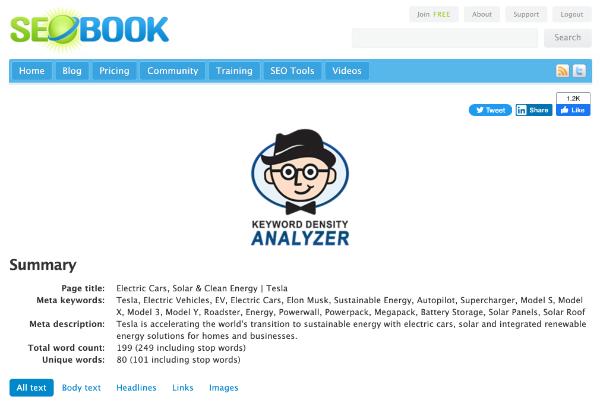
The keyword density analyzer tool is one of the SEO tools that helps you see how many keywords are on your page. This tool calculates keyword density based on the frequency of occurrence of different one word phrase, two-word, and tree-word combinations. The tool also calculates the TF, or total number of keywords, in your page.
Search engine ranking factors
Keyword density is a foundational concept in SEO, but how does it affect your site content? While it can affect the visibility of your site content on SERPs, keyword density is not a definitive measure of relevance. There are other factors, including domain age and authority, localization, and usage data, that can be more important than keyword density. Using a keyword density analyzer tool can help you understand these factors and how they affect your website’s ranking.
The density of keywords varies depending on the type of content that you’re writing. A timely news article, for example, may require fewer keywords to rank highly, whereas an evergreen blog post may require more. The density of keywords will also vary based on how much content you have.
Keyword density is calculated by multiplying the number of keywords in an article by the total number of words on the page. When you’re writing an article, make sure to include your focus keywords in the title tag, meta description, body, and alt tags. In addition, you should include them in internal links as well. In addition to these on-page factors, off-page variables like backlinks, anchor text, and keyword phrases also play a critical role in search engine indexing.
SEOBook’s keyword density analyzer tool is free, but you’ll need to sign up for an account before using it. This tool will check the keyword density of a web page and will also show you what the top ranked pages are for that keyword.
The tool calculates keyword density, and also identifies keyword stuffing. It also gives you tips on how to improve your content. This tool is a great addition to your SEO arsenal. You’ll have to remember that two percent is a good target for keywords.
While keyword density is one of the most important factors in search engine optimization, it can also be difficult to calculate. By simply dividing the number of times your keyphrase appears on a page by the number of words on the page, you’ll be able to calculate your keyword density. Just be careful not to stuff your pages with too many keywords – this can penalize your site.
In addition to analyzing the density of keywords in your content, you can incorporate the top keywords that are related to your content. You’ll want to avoid keyword stuffing – which is an old technique used to get good rankings. Using a keyword density analyzer tool can help you identify your top keywords and scatter them throughout your content.
Free keyword density analyzers
If you’re looking for a keyword density analyzer tool to help you optimize your website, you’ve probably come across the SEOBook tool. It has a number of features to help you optimize your website and is free to use. It tracks Google’s results for over 120 million keywords and can even track historical penalties or ranking issues. It also has a keyword density analyzer tool called DupliChecker that can check the density of your content. To use it, you’ll need to input a valid URL, highlight any elements, and select a section of text to analyze. The tool will then display the percentage of keywords that are present in the block of text.
 Until recently, keyword density was considered an important ranking factor by Google. However, with the introduction of Personalized Search and Latent Semantic Analysis, keyword density is no longer as relevant. Depending on the content of your page, you may not want to exceed 6% keyword density.
Until recently, keyword density was considered an important ranking factor by Google. However, with the introduction of Personalized Search and Latent Semantic Analysis, keyword density is no longer as relevant. Depending on the content of your page, you may not want to exceed 6% keyword density.
In addition to the SEOBook keyword density analyzer tool, you can use a free tool called SEO Review Tools. This tool allows you to compare five top-ranking websites and quickly identify which pages contain too many keywords. However, this free tool is limited because you’ll need to input the URL of your website and enter a captcha. Using this tool is a great option for beginners.
You can also use a free keyword density checker to determine the density of your content. This tool displays the percentage of keyword usage and the number of times each keyword appears. The result will tell you whether you’re using the right keyword density for your content. This tool is a powerful SEO tool that will provide you with accurate information.
The tool also shows which words have the highest density. While this can be helpful, it is limited when it comes to Meta Descriptions and Meta Titles. If you’re trying to optimize your website for search engines, it’s important to write in natural language that customers can read. If your content is too keyword-focused, Google will recognize it as ‘human unfriendly’ and deem it as unreadable, affecting its rankings.
The tool also lets you compare two pages side-by-side. This allows you to see which pages contain the most keywords, and which pages don’t. The tool can also help you analyze duplicate content. This tool is free and easy to use. The keyword density analyzer tool can help you stay on track and avoid penalties.
It’s important to know that keywords have a high impact on SEO ranking, so keyword density analysis is an important part of your search engine optimization campaign. The tool can also help you improve your page’s ranking and improve your SEO.
Calculating TF and IDF
The TF and IDF are two important parameters to calculate keyword density. The former is the relative weighting of terms in a document while the latter is the overall frequency of the word within the text. This tool calculates the density of a document by calculating the TF and IDF of each word. The TF value is calculated by taking the frequency of each word in the document and then multiplying it by a logarithm. The logarithm is used to avoid excessively high term frequency values from distorting the results.
The TF and IDF values are calculated by looking at the number of instances of a given word on a page. The higher the number of instances of a word, the higher the TF value. However, the lower the number, the lower the IDF value. Using the TF and IDF value, each word on a website receives a score that can be used to determine its importance in the content. Developed by British computer scientist Karen Sparck Jones, this tool is a great way to analyze the density of different words in content.
TF and IDF are crucial components of on-page optimization, but they are not a silver bullet. You need to focus on the most important terms and avoid over-optimizing text. As with other aspects of SEO, TF and IDF can’t make up for a poor backlink profile.
Besides determining the density of a keyword, the TF and IDF also give you a sense of how the words are used on a page. The TF score indicates whether the word is used too rarely, while the IDF score measures its importance. By interpreting TF and IDF, you can make your content more relevant and readable for search engines.
In addition to determining the keyword density, the SEObook keyword density analyzer tool can tell you how many times your keyword appears in a page. The tool provides a detailed report that allows you to determine which keywords to prioritize, and what competitors are doing with those keywords. The tool also gives you a list of your top competitors, giving you a clear picture of your competition.
The TF-IDF analysis tool can also be used to improve existing content. Though it is not a reverse-engineered Google algorithm, it is a great way to analyze how machines view your pages and make improvements. You can also use this tool to reverse-engineer your competitors’ content strategies.
Another keyword density analyzer tool is Visio Spark. This tool lets you compare your website with the top 10 competitors to determine what words or phrases to use. This tool can be used to create unique content and monitor keyword ranking success. The tool is free to download, so you can test it out for yourself.





